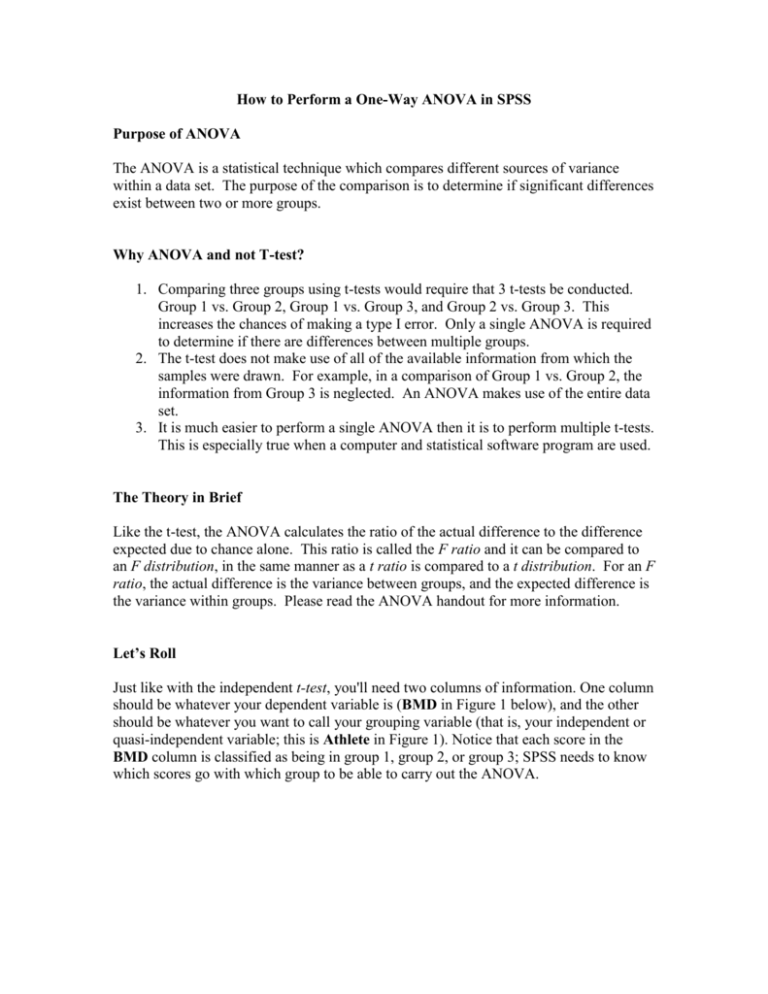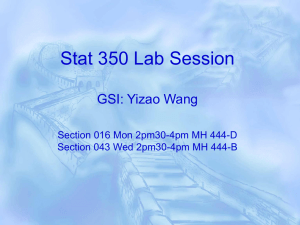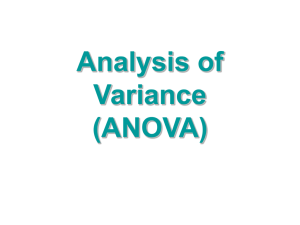How to Perform a One
advertisement

How to Perform a One-Way ANOVA in SPSS Purpose of ANOVA The ANOVA is a statistical technique which compares different sources of variance within a data set. The purpose of the comparison is to determine if significant differences exist between two or more groups. Why ANOVA and not T-test? 1. Comparing three groups using t-tests would require that 3 t-tests be conducted. Group 1 vs. Group 2, Group 1 vs. Group 3, and Group 2 vs. Group 3. This increases the chances of making a type I error. Only a single ANOVA is required to determine if there are differences between multiple groups. 2. The t-test does not make use of all of the available information from which the samples were drawn. For example, in a comparison of Group 1 vs. Group 2, the information from Group 3 is neglected. An ANOVA makes use of the entire data set. 3. It is much easier to perform a single ANOVA then it is to perform multiple t-tests. This is especially true when a computer and statistical software program are used. The Theory in Brief Like the t-test, the ANOVA calculates the ratio of the actual difference to the difference expected due to chance alone. This ratio is called the F ratio and it can be compared to an F distribution, in the same manner as a t ratio is compared to a t distribution. For an F ratio, the actual difference is the variance between groups, and the expected difference is the variance within groups. Please read the ANOVA handout for more information. Let’s Roll Just like with the independent t-test, you'll need two columns of information. One column should be whatever your dependent variable is (BMD in Figure 1 below), and the other should be whatever you want to call your grouping variable (that is, your independent or quasi-independent variable; this is Athlete in Figure 1). Notice that each score in the BMD column is classified as being in group 1, group 2, or group 3; SPSS needs to know which scores go with which group to be able to carry out the ANOVA. Figure 1: Data View How did I name the variables BMD and Athlete? There are two tabs at the bottom of the Data Editor, one labeled Data View, and the other labeled Variable View, as shown in Figure 1: You can toggle back and forth between the Data View (see Figure 1) and the Variable View, which is illustrated in Figure 2: Figure 2: Variable View In the Name column, you can type whatever labels you wish for your variables. If you don't type in labels, SPSS will use labels like VAR001 and VAR002 by default. When viewing the results of the ANOVA it will be helpful to know what each Athlete number represents. In our case, 1.00 is the Control group, 2.00 is the Swimmer group, and 3.00 is the Weight Lifter group. While in the Variable View, click on the Values cell of the Athlete variable to enter labels for each condition number. See Figure 3. Figure 3: Name the Grouping Variable To actually perform the ANOVA, you need to click on the Analyze menu, select Compare Means and then One-Way ANOVA, as in Figure 4. Figure 4: Starting the ANOVA After this, a dialog box will appear. In this box, you'll be able to select a variable for the "Dependent List" (this is what SPSS calls a dependent variable for this kind of analysis) and a "Factor" (this is the independent variable). I've selected BMD for the Dependent List and Athlete as the Factor, as show in Figure 5. Figure 5: Selecting the Test and Grouping Variables Notice also that there's an Options button. You should click this, and then, in the new dialog box that appears, check the Descriptives box (as illustrated in Figure 6a). This tells SPSS to give you descriptive statistics for your groups (things like means and standard deviations). You should also check the Homogeneity of variance test box, and the Means plot box Figure 6a: The Options Button After you click Continue, select the Post Hoc button and then OK, a new window will appear as shown in Figure 6b. Select Tukey which is a test that will determine specifically which groups are significantly different. Figure 6b: The Post Hoc Button After you click Continue and then OK, a new window will appear (called the SPSS Viewer) with the results of the ANOVA. The important part of the output is shown in Figure 7. Figure 7: The results of the ANOVA Descriptives BMD N Std. Deviation Std. Error Minimum Maximum Control 20 .9235 .19535 .04368 .8321 1.0149 .62 1.25 Swimmer 20 .9740 .29605 .06620 .8354 1.1126 .22 1.50 20 1.2100 .30253 .06765 1.0684 1.3516 .62 1.79 60 1.0358 .29299 .03783 .9601 1.1115 .22 1.79 Weight Lifter Total Mean 95% Confidence Interval for Mean Lower Upper Bound Bound Test of Homogeneity of Variances BMD Levene Statistic .974 df1 df2 2 Sig. .384 57 ANOVA BMD Sum of Squares .936 2 Mean Square .468 Within Groups 4.129 57 .072 Total 5.065 59 Between Groups df F 6.457 Sig. .003 There's a lot of useful information here. In the first box there are group statistics, which provide the means and standard deviations of the groups. The second box contains the results for the test of homogeneity of variance. Is the variance within each group similar? The high significance value (.247) is good because it means we do have homogeneity of variance. We would have to make adjustments to our analysis if the significance approached .05. In third box are the results of the ANOVA, in a summary table that should look almost exactly like Table 9.6 from the handout. You do not need to look up a critical value for F to decide if you should reject the null hypothesis or not. Instead, just compare the "Sig." value to alpha (which is usually .05, as you know). The decision rule is as follows: If the significance value (which is usually labeled p in research reports) is less than alpha, reject H0; if it's greater than alpha, do not reject H0. So, in this case, because the significance value of .003 is less than alpha = .05, we reject the null hypothesis. We would report the results of this ANOVA by saying something like, "There was significant differences between the groups, F(2, 57) = 6.457, p = .003." Now that we know the groups are significantly different, it would be helpful to determine specifically which groups are different from each other. For this we can review the Post Hoc test (in this case Tukey). See Figure 8 Figure 7: The results of the Tukey Post Hoc Tests Post Hoc Tests Multiple Comparisons Dependent Variable: BMD Tukey HSD 95% Confidence Interval Mean Difference (I-J) -.05050 Std. Error .08511 Sig. .824 Upper Bound -.2553 Lower Bound .1543 -.28650(*) .08511 .004 -.4913 -.0817 .05050 .08511 .824 -.1543 .2553 -.23600(*) .08511 .020 -.4408 -.0312 .28650(*) .08511 .23600(*) .08511 * The mean difference is significant at the .05 level. .004 .020 .0817 .0312 .4913 .4408 (I) Athlete Control (J) Athlete Swimmer Weight Lifter Swimmer Control Weight Lifter Weight Lifter Control Swimmer From the table, we can see that the Swimmer group does not differ significantly from the Control, but the Weight Lifter group is significantly different from the Control. We can also see that the Weight Lifter group is also significantly different from the Swimmer group. Note that these significant values are slightly different than the one’s determined using the Scheffe Post Hoc test in Excel. However, the end result is the same. Tukey is slightly more powerful than (smaller p-values) than Scheffe. The difference between groups is confirmed graphically by looking at the Plot of Means shown below. 1.30 Mean of BMD 1.20 1.10 1.00 0.90 Control Swimmer Athlete Weight Lifter









